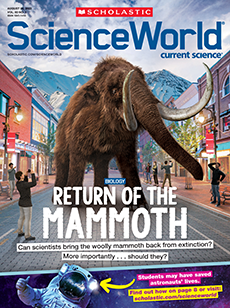AARON LEBLANC
ORANGE EDGE: Komodo dragon teeth are capped with an orange layer of iron.
Aaron LeBlanc was examining the preserved remains of a Komodo dragon—the world’s largest lizard—when he noticed the tips of its teeth had a faint orange stain. At first, this confused LeBlanc. He’s a paleontologist—a scientist who studies ancient life—at King’s College London in England. It looked “like someone took an orange marker and painted the edges of the teeth,” he says. Eventually, his team discovered that the teeth were orange because they were coated with a thin layer of the element iron (Fe). Komodo dragons are carnivores, or meat eaters. LeBlanc thinks the metal coating helps the lizards’ teeth stay sharp so they can tear through the flesh of their prey.
